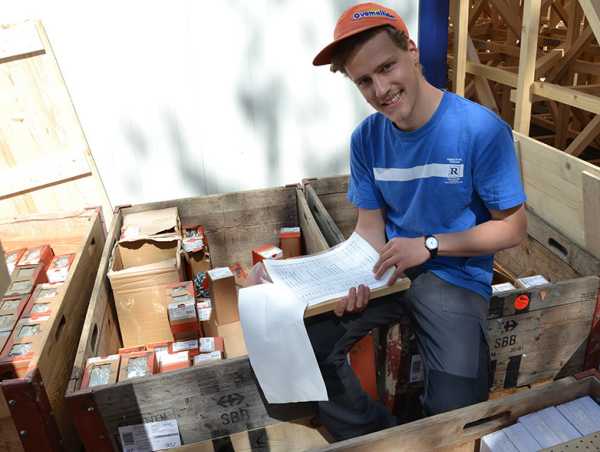The Manifesta Pavilion has been anchored
Thirty architecture students from ETH Zurich’s Studio Tom Emerson have made their first venture into a large-scale project. After ten months of intensive work, the Pavilion of Reflections is ready on time for the opening of the Manifesta 11 European Biennial of Contemporary Art in Zurich.
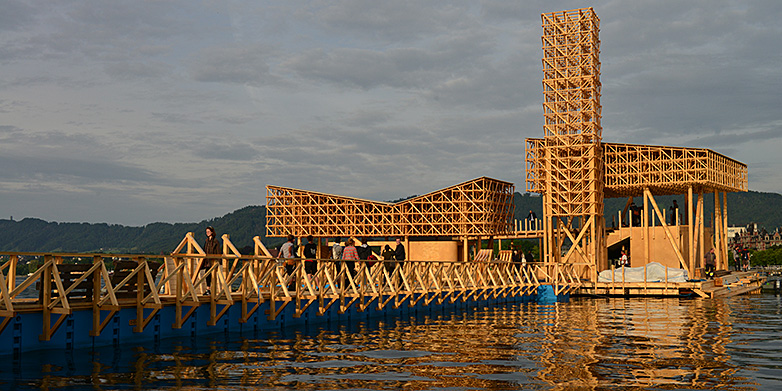
Finished at last: At 6.30 am. yesterday, the Pavilion of Reflections was moored at Bellevue, Zurich. For 100 days, the pavilion will act as a nucleus and focal point for the thousands of visitors to the Manifesta 11 European Biennial of Contemporary Art in Zurich. The pavilion’s 150 tonnes of wood and steel had to be hauled by barge across the lake from the Mythenquai to Bellevue. The unique project, which involved some 30 students from ETH Zurich’s Department of Architecture, has now been successfully completed.
Professor Tom Emerson took on the project in summer 2015, along with his assistants Boris Gusic and Adrian Heusser. “We've never carried out a project of this scale with students before,” says Gusic. The studio does frequently build pavilions with students, but these are much smaller structures that can be put together in a shorter timeframe – all but one of them were designed and built in less than two weeks.
“It has always been a privilege to work with the students at ETH but to be able to realise an important cultural project in lake Zurich is a once in a lifetime opportunity for everyone concerned,” says Professor Tom Emerson. “The students’ imagination for the Pavilion of Reflection is matched only by their tenacity to realise it in all its complexities with exceptional skill. It is an unforgettable experience for us, the students and hopefully for all of Zurich too”.
Voyage of a pavilion
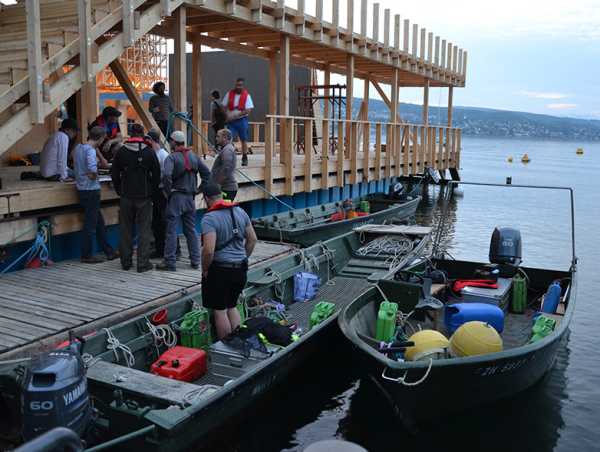 Ready for laying: Three long boats are enough to haul the 150-tonne construction.
Ready for laying: Three long boats are enough to haul the 150-tonne construction.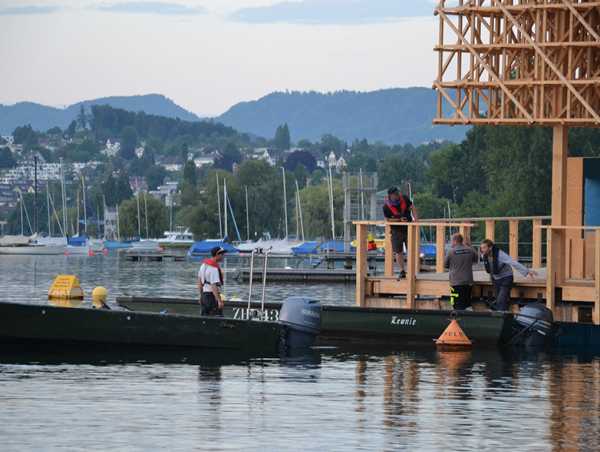 The platform made good progress.
The platform made good progress. Unusual encounter on the lake.
Unusual encounter on the lake.
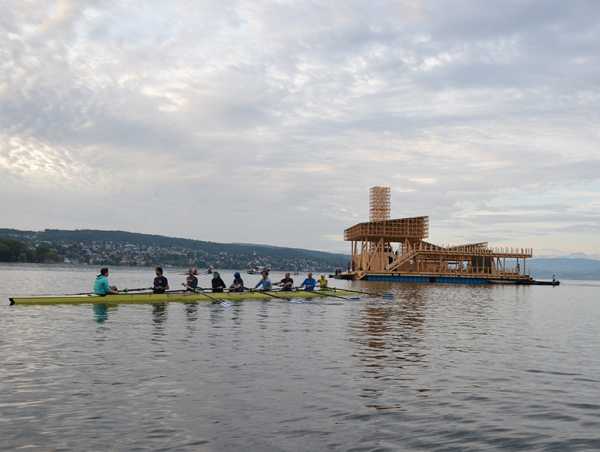 The pavilion is anchored in front of the Bellevue.
The pavilion is anchored in front of the Bellevue. Still, the Pavilion of Reflections is a bit lopsided.
Still, the Pavilion of Reflections is a bit lopsided. Hardly anchored, the pavilion is well attended.
Hardly anchored, the pavilion is well attended.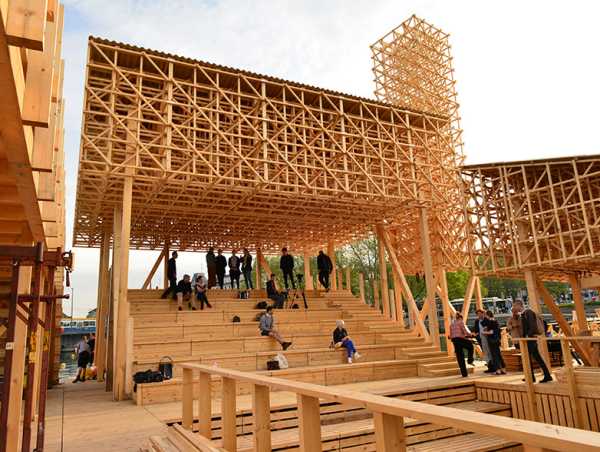 The construction is characterized by a network of wooden beams.
The construction is characterized by a network of wooden beams. Pavilion of Reflections, literally.
Pavilion of Reflections, literally. Pleased with the success: Adrian Heusser, Tom Emerson and Boris Gusic (from left).
Pleased with the success: Adrian Heusser, Tom Emerson and Boris Gusic (from left).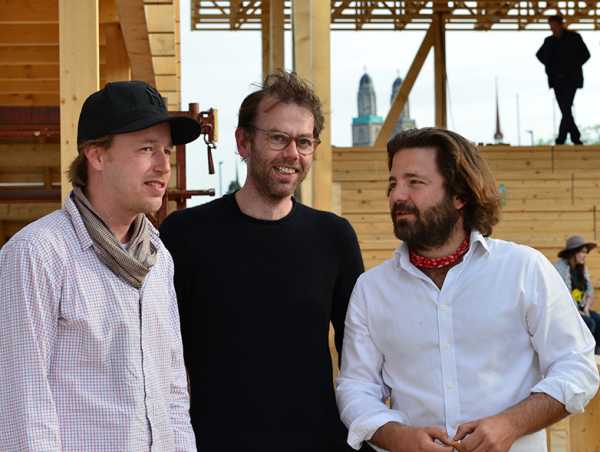
A unique large-scale project
The Manifesta pavilion is on a different scale altogether: it has a 600m2 footprint, required extensive planning time, and must meet specific requirements. As the pavilion is a public building that can accommodate up to 300 visitors, it has to comply with all fire safety regulations. On top of this, the Manifesta organisers laid down some challenging guidelines: it had to be a floating structure featuring an outdoor swimming pool and toilet facilities, as well as a spectator stand and a large screen for showing films.
“We began planning on 4 August 2015, way before the start of term,” recalls Kathrin Füglister, a Master’s student in Architecture in her seventh semester. In order to give the pavilion its distinctive appearance, the 30 students came up against each other in a competition.
“There were a lot of promising designs that we combined and developed,” says Anna Maria Stallmann, a Master's student in Architecture in her eighth semester. While some of the students worked on fine-tuning the design in small groups, others built pavilion prototypes on the roof of the HIL building on ETH’s Hönggerberg campus.
Construction of the pavilion
The design was just the beginning
“There were a lot of things that we misjudged at the start of the project,” admits Jonatan Egli, a Master's student in Architecture in his ninth semester. In fact, the students found that the hard work started only after the design was completed. They had to check over their structural calculations and clarify a number of different requirements with the authorities. They also needed to calculate and order the amount of materials required. For the wooden structure alone, 350m3 of Swiss logs and 140m3 of wooden boards and beams were cut.
They also had to coordinate with the many experts participating outside of the build itself. The steel structure was the result of a collaboration with Willy Stäubli AG at the port of Bäch (SZ), while the students got help from the apprentices at the Gewerbliche Berufsschule Wetzikon during the first week of the pavilion's construction.
In order to have the pavilion ready on the Mythenquai in under four weeks, the 30 ETH students spent their winter semester holidays bolting together parts in an assembly hall in Winterthur Grüze.
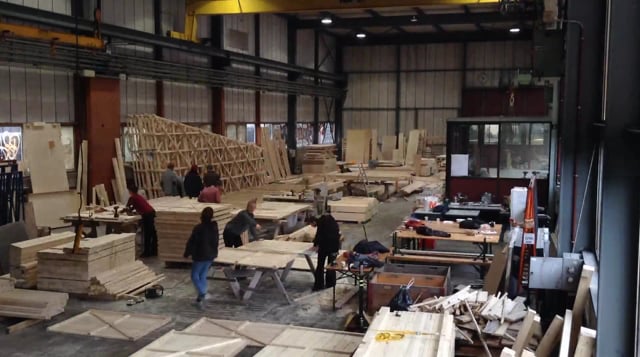
“The project demanded more than just technical knowledge,” says Kathrin Füglister. Building the pavilion presented a number of potential pitfalls, she explains. “Before we could get started, we had to learn how we could work together most efficiently and decide who would do what.” Füglister worked on the construction of the sun deck, among other jobs, while Anna Maria Stallmann took on the construction of the spectator stand, where visitors will be able to stop off to relax or watch a film. Jonatan Egli became “lord of the bolts”; acting as the intermediary between the various engineers and technicians, he was responsible for planning how to put together the individual structural parts. “In total I ordered over 150,000 bolts and made sure they were used in the right places,” he says.
Seeing the project through
Despite the project's challenges, the students remain enthusiastic. “It makes an amazing change from day-to-day student life, and we were able to see a project through from start to finish for the first time,” says Stallmann. Egli adds that working on the project gave him the first real taster of what it's like to work as an architect.
The project will soon be ready for its first visitors. From 11 June, you will be able to walk across the 50-metre-long jetty to the Manifesta pavilion and watch films about the Biennial’s featured artworks, order drinks and snacks at the bar, or cool off in the pool.
Manifesta 11 – ETH's contribution
Manifesta 11, the European Biennial of Contemporary Art takes place in Zurich from 11 June to 18 September. As well as Professor Tom Emerson, who designed the Pavilion of Reflections on Lake Zurich, Professor Alex Lehnerer, doctoral student Mathias Bürki and a number of other ETH members will also be taking part. Alex Lehnerer’s group will be transforming the Cabaret Voltaire into a external page“Guildhall of the Arts”call_made. The “Voltaire Guildhall” will be Zurich’s 27th guildhall, complete with the appropriate conventions and aspirations. It is reserved for those in artistic professions and you may only become a member if you are involved in a “joint venture performance” of an artistic nature. During the summer, the Guildhall will become a central performance location for Manifesta 11. Bürki is working in collaboration with French artist Marguerite Humeau. They are researching the origins of love and attempting to reconstruct the first appearance of the emotion in the evolutionary history of mammals. In order to do this, they are programming two autonomous, artificial beings. The project is one of 30 joint ventures between various artists from around the world and from different professions. Each of these projects will be presented in three different formats: at a “satellite” event, at an art institution, and as films on the Pavilion of Reflections.
Manifesta 11, the European Biennial of Contemporary Art, 11 June – 18 September 2016, Zurich. For the full programme and further information see: external pagehttp://m11.manifesta.orgcall_made




